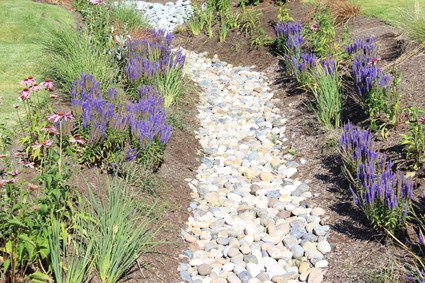WATER QUALITY IMPROVEMENTS

Celebrating World Soil Day: Preventing Soil Pollution and Erosion
World Soil Day is celebrated each year around the world on December 5th to raise awareness for healthy soils and soil erosion prevention. The health of our soils affects the food we eat, the water we drink, the air we breathe, our human health, and the overall health of our environment. We can all do our part on World Soil Day – and every day – to protect the quality of our soils by preventing soil pollution and soil erosion.
Soil pollution is mainly caused by not applying fertilizer and pesticides correctly; inappropriately disposed trash, yard debris, or pet waste; and overuse or improper disposal of plastics and packaging. When these pollutants enter the storm drain system through runoff, from rainfall or outdoor watering use, they can fill in streams, block sunlight that organisms need to live, and affect the overall quality of our water. Unlike our sanitary sewer system, pollutants entering our storm drain system are not treated, and can be harmful to our local creeks, rivers and ocean.
Soil erosion is the removal of the most fertile top layer of soil through water, wind, and tillage. Erosion is the #1 threat to soil and can result in a 50% loss in the amount of food produced for our consumption. In addition to affecting the health of our soil, soil erosion also contributes to flooding and mudslides. Soil erosion prevention is especially critical for fire and rainy season safety.
|
Tips & Techniques for Soil Pollution and Erosion Prevention
Soil Pollution Prevention Tips
-
Fertilizer and Pesticides – Apply fertilizer and pesticides according to the label’s application rate and only as much as is needed. When possible, use eco-friendly alternatives to fertilizer and pesticides and implement Integrated Pest Management (IPM), a process to manage pest problems while minimizing risks to people and the environment. Properly dispose of any unused chemicals by taking them to a local Household Hazardous Waste (HHW) facility.
-
Trash/Yard Debris/Pet Waste – Garbage can literally take thousands of years to decompose and can be detrimental to our waterways. Properly dispose of trash and yard debris in curbside receptacles and ensure lids are secure to prevent blown trash and debris. Promptly pick up pet waste and dispose of it in the trash or down the toilet. Compost yard trimmings and food waste to reduce waste and add nutrients to your soil.
-
Excess Plastics and Packaging – Plastics form a significant portion of the waste that ends up in landfills and the ocean. In landfills, plastics and other materials decompose slowly and release toxic materials into the soil. Recycle single-use plastics such as water bottles and food containers, and where possible, opt for biodegradable products like packaging cartons that easily break down to become part of the soil.
-
Irrigation Runoff --Runoff from properties can carry large amounts of soil and sediment. Although soil and sediment are natural substances, if they enter our storm drains, they can negatively affect our water quality and harm aquatic life. Manage irrigation practices to prevent pollutants from sidewalks and driveways from washing into the soil or our storm drain system. Adjust sprinklers so they don’t spray onto streets or sidewalks and repair leaking or broken sprinklers as soon as possible.
Soil Erosion Prevention Techniques
Use the following techniques, or Structural Best Management Practices (BMPs), to help prevent soil and sediment from leaving your property, entering nearby storm drains, and impacting our waterways:
-
Soil Retention -- Practice erosion-avoidance techniques such as adding mulch or rocks to the soil, installing fiber rolls or straw wattles, and properly using sandbags.
-
Plantings/Vegetation -- Plant trees, shrubs, or ground cover on slopes to help keep topsoil in place and facilitate the soaking of rainwater into the ground. Use drought-tolerant or native plants to reduce water use.
-
Drainage/Water Infiltration -- Install Infiltration beds, swales, and basins that allow water to collect and soak into the ground to help retain water and filter polluted runoff. Pervious or porous surfaces like permeable pavers or porous concrete can also help minimize runoff.
For additional information on how to maintain the health of our soils and waterways, see our soil & sediment erosion prevention page and brochure, and additional techniques to prevent erosion around your home or at construction sites.

|